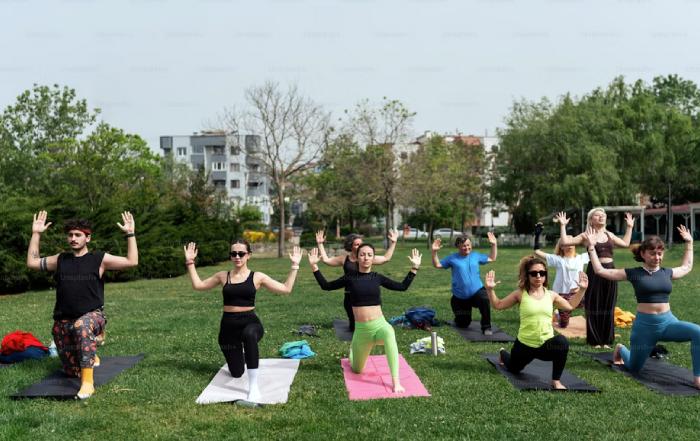As the global fitness routine rolls on with extraordinary momentum, the convergence of advanced artificial intelligence and personalized digital coaching has fundamentally redefined how individuals engage with health, performance, and long-term well-being. What began as simple activity trackers and step counters has evolved into comprehensive ecosystems powered by machine learning models, predictive analytics, and biometric intelligence capable of generating deeply personalized experiences. This shift reflects a growing demand for insights that are not only accurate but also contextually meaningful, actionable, and aligned with the realities of modern life. Readers of FitBuzzFeed—many of whom actively follow global developments in sports, health, business, and technology—understand how innovation in this sector continues to accelerate across regions and industries.
The pressures of contemporary living, including widespread sedentary behavior, rising rates of chronic disease, and heightened workplace stress, have amplified the need for data-driven frameworks that support sustainable health improvement. Health authorities such as the World Health Organization routinely emphasize the value of preventive care and consistent physical activity, a message reinforced by research from sources such as Harvard Health Publishing and Cleveland Clinic, which confirm that digital engagement often leads to stronger adherence than traditional interventions. As a result, governments, corporations, and global wellness leaders are investing heavily in intelligent technologies that bridge the gap between professional expertise and everyday behavior.
The Shift Toward Deep Personalization Through AI
Artificial intelligence has ushered in a new era of personalization that goes far beyond the static workout templates of earlier apps. Modern platforms backed by major innovators such as Apple, Google, Samsung, and Garmin now analyze a wide spectrum of variables including sleep quality, stress markers, metabolic signals, movement patterns, and environmental conditions. Users seeking more information about this evolution can explore resources like Learn more about wearable technology innovation, which detail how modern sensors have achieved unprecedented levels of accuracy.
The core strength of AI is its ability to interpret data within context. A runner using an intelligent coaching app is no longer limited to pace and distance; instead, personalized insights now consider historical performance trends, surface type, weather conditions, air quality, and biomechanical fatigue. A strength trainee receives real-time form analysis generated through movement-recognition algorithms supported by machine learning models. These guidance systems evolve continuously, becoming more accurate as they learn from the user’s behavior and physiological responses. Readers researching personal performance improvement through FitBuzzFeed’s training section appreciate how this level of personalization enhances both efficiency and safety.
AI-driven coaching has also improved the effectiveness of human professionals. Trainers, physiologists, and medical specialists now have access to comprehensive dashboards that consolidate biometric trends, behavioral patterns, and training metrics. Organizations such as American College of Sports Medicine and National Academy of Sports Medicine integrate these advancements into certification programs that uphold global standards of expertise. For many professionals exploring career opportunities highlighted in FitBuzzFeed’s jobs section, AI has become a valuable tool that enhances—not replaces—the human element of coaching.
Global Demand for Smarter Fitness Technology
Demand for advanced fitness platforms continues to climb across regions including the United States, United Kingdom, Germany, Canada, Australia, France, Italy, Japan, Singapore, South Korea, China, and rapidly developing markets across South America, Africa, and Southeast Asia. In all these environments, digital fitness has become part of broader initiatives aimed at modernizing healthcare, promoting preventive care, and supporting population-level well-being. Nations with strong traditions of physical activity, such as the Netherlands, Sweden, Norway, and Switzerland, increasingly rely on AI-backed monitoring tools to reinforce government-supported wellness programs. Meanwhile, mobile-first economies in Africa, Asia, and South America embrace fitness apps as accessible alternatives to gym memberships or specialized coaching.
Studies from Statista and MarketWatch reveal that digital fitness revenues continue to experience double-digit annual growth, driven by both consumer adoption and corporate wellness initiatives. Companies such as Nike, Peloton, Whoop, and Oura are forming powerful partnerships that integrate business, technology, and health, fueling innovation and expanding their global footprint. Readers following corporate developments on FitBuzzFeed’s business section recognize the pivotal role of these companies in shaping the future of health engagement.
Digital fitness also contributes to public health priorities. Universities, governments, and international sports bodies including FIFA and the International Olympic Committee utilize AI-enhanced tools to improve youth athletic development and optimize elite performance. Insights into global wellness trends available through FitBuzzFeed’s world section reflect how deeply embedded digital fitness has become in policy, education, and economic strategy.
AI Fitness Coach Matcher
Discover your personalized AI-powered fitness solution
The Evolution of Personalized Coaching in a Digitally Connected Era
In 2025, digital coaching frameworks offer a level of precision and adaptability that significantly surpasses traditional in-person models. Coaches now rely on continuous biometric data, adaptive feedback loops, and AI-powered analysis to monitor client progress with far greater accuracy. Multimedia tools, video evaluations, and real-time communication support global clients across multiple time zones and cultural backgrounds. Resources like Learn more about sports performance science illustrate how digital tools have democratized access to scientific insights once limited to elite sports programs.
From marathon training to injury rehabilitation, AI-assisted coaching tailors programs according to user-specific constraints, environmental factors, and physiological responses. Readers of FitBuzzFeed’s physical performance section frequently explore how customized programming protects against overtraining and accelerates progress.
AI has also raised expectations around professional qualifications and accountability. Coaches integrating these tools are expected to interpret data through frameworks backed by organizations such as American Heart Association, Canadian Society for Exercise Physiology, and British Journal of Sports Medicine. FitBuzzFeed readers exploring brand credibility within the brands section regularly evaluate companies based on their scientific rigor and ethical standards.
Behavioral Insights and Habit Formation Driven by AI
The ability of AI to analyze behavioral patterns represents one of the fitness industry's most significant breakthroughs. Behaviorally intelligent algorithms use machine learning to identify moments of vulnerability, track motivational fluctuations, and recommend habit-building interventions that reflect psychological principles. Insights from the American Psychological Association help explain how these models support long-term adherence.
AI-powered journaling, mindfulness tools, and stress analytics demonstrate how emotional health influences training outcomes. Readers exploring holistic wellness on FitBuzzFeed’s wellness section appreciate how behavioral awareness complements physical fitness.
AI can detect early signs of burnout using markers such as sleep disturbances, HRV trends, and cumulative training load. This supports populations in demanding regions like the United States, Japan, and Germany, where work-life stress often intersects with intense training. Tools grounded in behavioral therapy principles, such as those supported by Mayo Clinic, help users maintain consistent routines and recover from lapses without discouragement.
The Future of Wearables and Biometric Intelligence
Modern wearables provide unprecedented access to physiological data. Devices from Garmin, Whoop, Fitbit, Apple, Huawei, and Xiaomi monitor variables such as neuromuscular strain, sleep architecture, HRV, blood oxygenation, and metabolic fluctuations. Resources like Learn more about biometric wearables offer detailed insights into sensor innovations shaping this transformation.
Wearables now integrate with cloud-based predictive engines that generate holistic interpretations of long-term data. Continuous glucose monitoring, once reserved for medical patients, has reached mainstream fitness applications. Readers exploring the role of nutrition and metabolism on FitBuzzFeed’s nutrition section appreciate how these insights shape dietary behaviors.
Wearable adoption spans corporate wellness, elite sports, healthcare institutions, and public health initiatives. Governments in Singapore, South Korea, and Sweden integrate wearable data into population wellness programs. Professional sports teams adjust training strategies using real-time analytics. These trends demonstrate the trustworthiness and effectiveness of AI-supported biometric ecosystems.
The Intersection of Fitness Apps and Global Health Trends
Fitness applications now play a crucial role in national health strategies, especially as chronic diseases rise across continents. Many countries in Europe, Asia, North America, and emerging markets leverage digital coaching to improve population-level well-being. Insights from WHO reveal how early intervention through fitness reduces long-term healthcare burdens.
Mobile-first markets in Africa, South America, and Southeast Asia rely heavily on cost-effective digital tools to supplement limited access to physical fitness facilities. This expansion reflects the democratization of expert coaching—a trend covered frequently in FitBuzzFeed’s world news section.
High-income nations such as Switzerland, Japan, and Canada integrate fitness data into healthcare systems, enabling physicians to track patient recovery through digital rehabilitation platforms. Research from Johns Hopkins Medicine supports remote monitoring as a method to improve recovery rates and treatment compliance.
The Corporate Role in Shaping the Digital Fitness Revolution
Corporations increasingly adopt AI-driven wellness platforms to improve productivity, retention, and overall workplace satisfaction. Insights from SHRM emphasize the economic benefits of health-focused corporate culture.
Partnerships between Microsoft, Amazon, Deloitte, and digital fitness platforms demonstrate an industry-wide shift toward comprehensive wellness infrastructure. FitBuzzFeed’s business section frequently highlights how health investments support organizational resilience.
The rise of hybrid work prompted widespread adoption of ergonomic tools, virtual workouts, and stress reduction programs across the United States, UK, Australia, and parts of Europe. Publications like Harvard Business Review reinforce how data-informed wellness culture strengthens leadership and teamwork.
The Merging of Lifestyle, Mobility, and Digital Fitness
Modern fitness extends into travel, recreation, nutrition, and mental health. Apps that integrate training with travel insights—such as those referenced on Lonely Planet—optimize routines for jet lag, climate changes, and sleep disruption.
Performance nutrition powered by AI helps users navigate evolving dietary landscapes including gut health, plant-based diets, and metabolic optimization. Readers often explore these multidimensional lifestyle strategies on FitBuzzFeed’s lifestyle section.
Outdoor and recreational athletes benefit from predictive analytics that assess terrain difficulty, environmental risks, and weather conditions. Publications such as Outside Online highlight how technology enhances safety and enjoyment in outdoor fitness.
The Future of Immersive Fitness Experiences
Virtual, augmented, and mixed reality platforms developed by Meta, Sony, and HTC are redefining how users experience fitness. Articles from Wired detail how these technologies deliver sensory-rich simulations that boost motivation and learning.
Immersive fitness supports rehabilitation, sports training, mobility enhancement, and global social engagement through virtual classes and competitions. FitBuzzFeed’s events coverage showcases how global fitness communities participate in hybrid digital gatherings.
Data Ethics, Privacy, and Responsible AI Adoption
With immense data collection comes the responsibility to protect user privacy. Regulatory frameworks such as GDPR and CCPA guide responsible data practices. Insights from EFF highlight the importance of transparency, consent, and algorithmic fairness.
Organizations must ensure that AI personalization enhances autonomy—not replaces it. Ethical design principles promoted by global health bodies encourage user choice, accessibility, and cultural inclusivity. Readers who follow FitBuzzFeed’s news section understand that responsible innovation is essential for long-term trust.
Economic Impact and Market Forecast for AI Fitness
Economic forecasts from firms like Grand View Research project continued expansion of digital fitness across subscription services, analytics platforms, and wearable ecosystems. Companies such as Peloton, Nike, Tempo, Apple, and Whoop continue to expand into global markets, forging partnerships in healthcare and elite sports.
Emerging markets in India, Brazil, Indonesia, and South Africa drive additional growth, presenting opportunities for accessible digital coaching. FitBuzzFeed readers exploring the sports section see how these markets influence global performance trends.
The Convergence of AI Coaching and Human Expertise
Despite technological advances, human expertise remains central to effective coaching. AI enhances professional capabilities, enabling coaches to focus on personal connection, motivation, and judgment. Resources such as ACSM demonstrate how science-backed coaching remains foundational across fitness disciplines.
This hybrid model improves global consistency, ensuring users in Japan, Canada, or Italy experience high-quality guidance grounded in research and AI interpretation.
Conclusion: A New Era for Intelligent Fitness and Global Well-Being
The future of fitness applications marks a pivotal moment in global health and performance. As AI-powered coaching, immersive environments, biometric wearables, and behavioral modeling reshape the fitness landscape, individuals gain access to tools that align personal aspirations with scientific precision. From developed markets across Europe and North America to emerging regions in Asia, Africa, and South America, digital fitness has become an essential companion for navigating modern life.
For FitBuzzFeed’s international audience—professionals, athletes, enthusiasts, and health-conscious individuals—the fusion of personalized coaching and advanced analytics represents a new era of empowerment. Fitness technology has transformed from basic tracking to strategic lifestyle enhancement, enabling users worldwide to pursue long-term well-being with confidence, clarity, and expert support.










